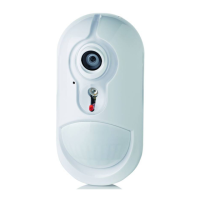4 D-302893
5. LOCAL DIAGNOSTICS TEST
A. Separate the base from the cover (see Fig. 5).
B. Put back the cover to return the tamper switch to its normal
(undisturbed) position, and then secure the front cover to the
base with the case closure screw.
C. The NEXT CAM will enter a 2 min. stability period. During this
time the red LED blinks.
D. Walk-test the coverage area - see fig. 2. Walk across the far
end of coverage pattern in both directions, The red LED lights
each time your motion is detected followed by 3 LED blinks.
The following table indicates received signal strength
indication.
LED response Reception
Green LED blinks Strong
Orange LED blinks Good
Red LED blinks Poor
No blinks No communication
IMPORTANT! Reliable
reception must be assured.
Therefore, "poor" signal
strength is not acceptable.
If you receive a "poor"
signal from the detector, re-
locate it and re-test until a
"good" or "strong" signal
strength is received.
Note: For detailed Diagnostics
Test instructions refer to the
control panel Installer Guide.
A
A. Enroll button
Figure 3. Device enroll button
6. INSTALLATION
6.1 General Guidance (see fig. 4)
1. Keep away from heat
sources.
2. Do not expose to air
drafts.
3. Do not install outdoors.
4. Avoid direct sunshine.
5. Keep wiring away from
power cables.
6. Do not install behind
partitions.
7. Mount on solid stable
surface.
WARNING! To comply with FCC RF exposure compliance
requirements, the PIR detector should be located at a distance of
at least 20 cm from all persons during normal operation. The
antennas used for this product must not be co-located or
operated in conjunction with any other antenna or transmitter
1 2 3
4 5 6
7
Figure 4. General Guidelines
Important! The Next CAM-K9 PG2 detector is immune to 38 kg
(85 lb) animals moving on the floor or climbing on furniture as
long as the activity takes place below 1 m (3 ft). Above the 1 m
(3 ft) height limit, the detector is immune to 19 kg (42 lb) pets,
but the pet immunity will decrease as the pet gets closer to the
detector. It is therefore recommended to select a mounting
location that minimizes potential close proximity of animals.
6.2 Mounting
1
2
3
A

